
My 12 injectors
looked like this:

I cleaned them
with some degreasing solvent and compressed air:
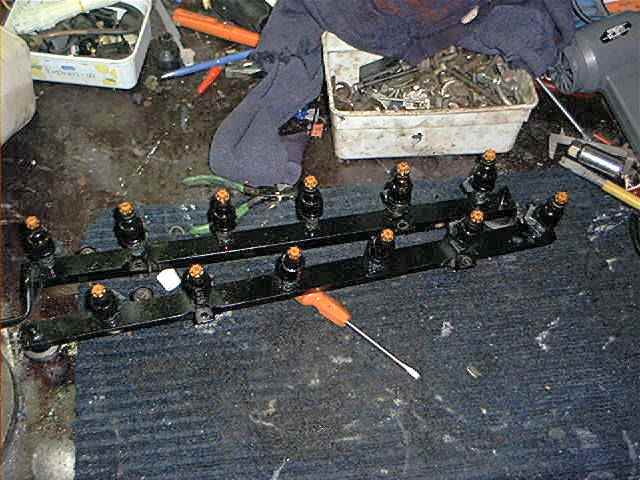
I also cleaned
the injector holes (bores) with the same solvent and an old
toothbrush (intake manifold removed to clarify the process):

Now comes the
tricky part, unbolting the lower bolts of the intake manifold.
The trick is to use a 10mm 1/4" socket with a 1/4'' swivel
and alot of extensions. I used a 3/8" ratchet with a
1/4"-3/8" adapter to apply more torque:
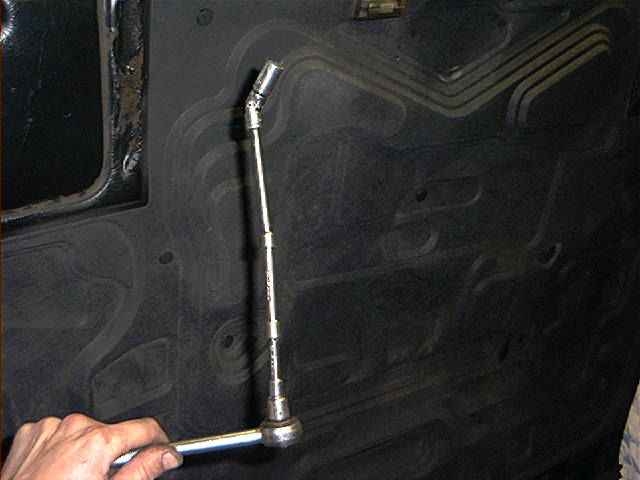
For the lower bolts the 10mm
socket must be magnetic to prevent the bolts falling into the
valley between both banks (pretty important when reinstalling). I
can assure you, no one I know has magnetic sockets. Neither do I,
so I used an old trick. Put some wheel bearing grease into the
socket (its a bit out of focus, but you'll get the point):
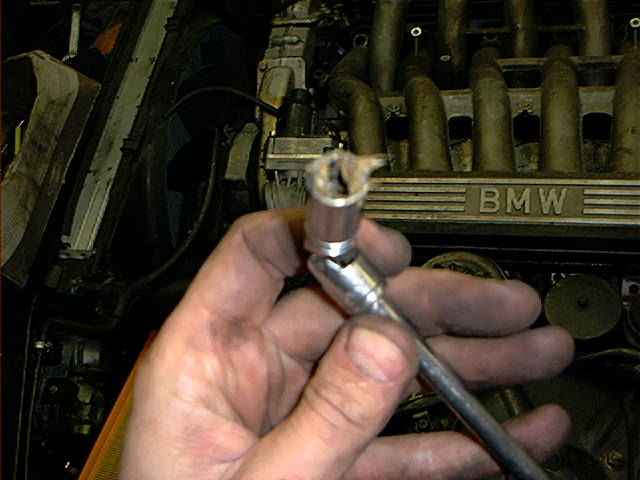
I also greased up the swivel, to
make it less flexible. A swivel that swivels to smoothly causes
severe headache when you are trying to reach those bolts:
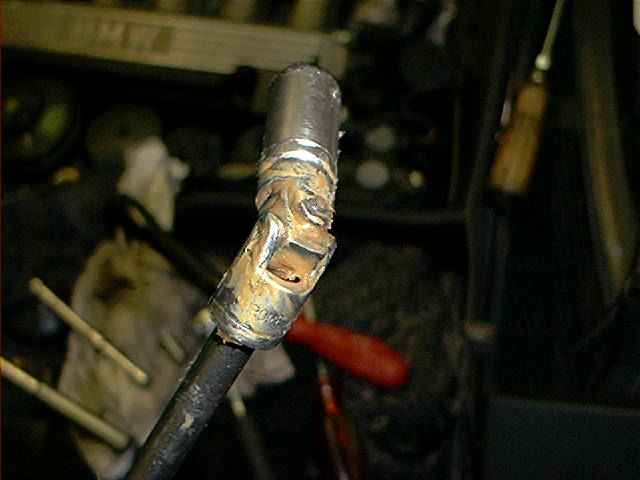
Next pictures are showing the removal of the lower bolts.
REMARK: the photos are showing that my ratchet and extensions use the small space between both manifolds. For easier access, you could remove the bolts of the noise suppressor (see schematic overview at the beginning of this article) and move the noise suppressor to the back of manifold, allowing a better access to the lower bolts. I described that procedure in the 'valve stem seal replacement' section.
The noise suppressor is nothing
but a piece of plastic with some isolation, together with the
engine cover it prevents noise from the injectors:
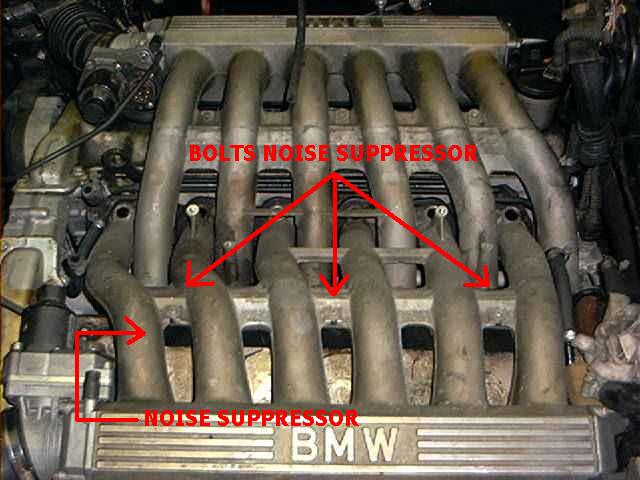
Again, I didn't remove the noise
suppressor, notice the lack of space you have. No space for
anything bigger than a 1/4" swivel. Time to start unbolting.
I started at 2 bolts near the firewall, which in my opinion where
the worst to get at:
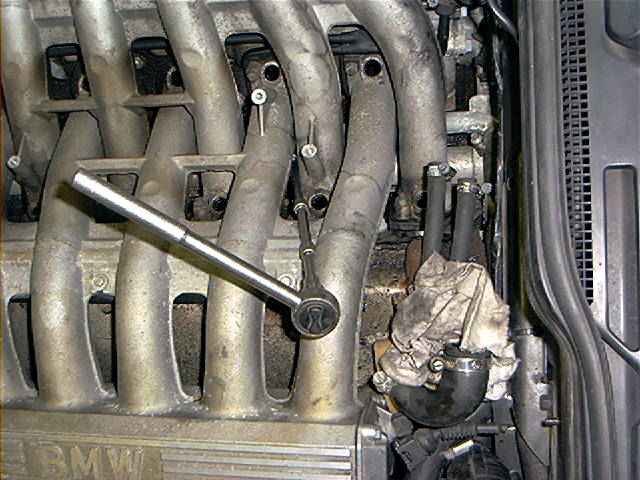
Later (see second part at the
end of this section) I did remove the intake manifolds for the
second time, and this time I removed the noise suppessor. Acces
was a lot easier now, and without swivels:

It's up to you which procedure you use. See section 'valve stem seal replacement' for more pictures about this procedure.
The bolts where sometimes very
hard to see. I used a small electric torch:
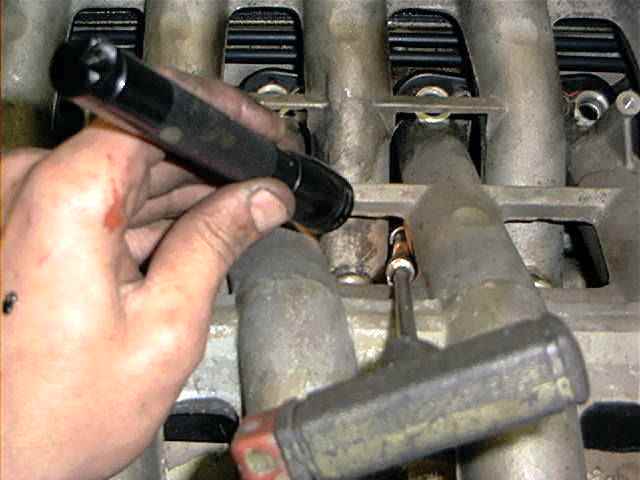
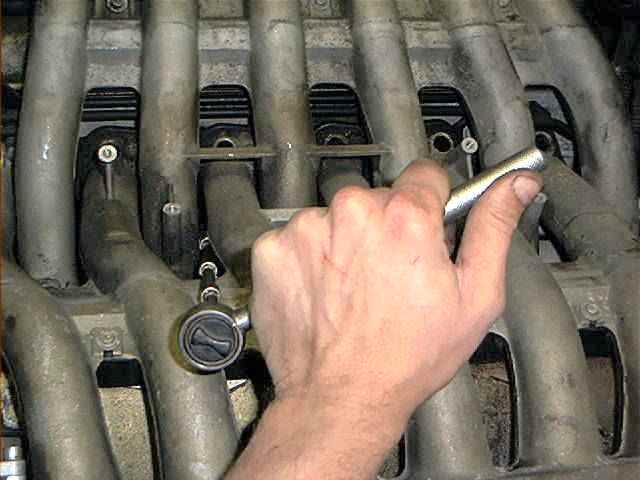
A removed bolt, nicely sticking
to the grease ;-) :

When all lower bolts are
removed, pass on with the upper bolts, which are relatively easy:
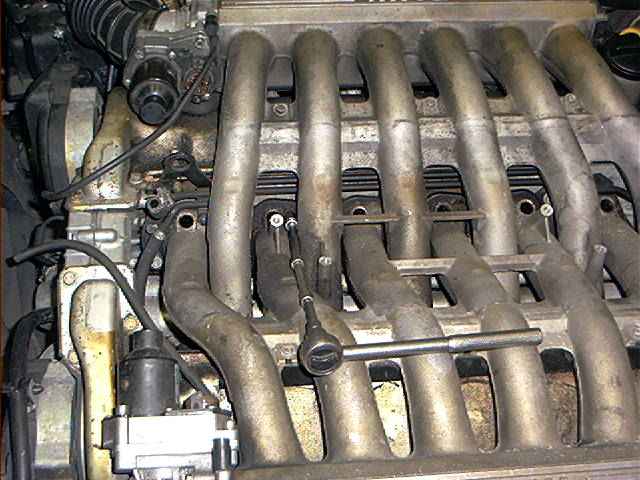
When all bolts are removed, detach the left intake manifold from the cylinder head. Notice the intake gaskets. On the photo it looks like 6 separate gaskets, but they aren't. These are 2 massive gaskets, bolted with other bolts (not the bolts you removed!) to the cylinder head. Therefore, you can't remove these gaskets now, you have to remove the other manifold for that.
When replacing the gaskets
(which I didn't), just must replace both gaskets and you cannot
replace the gaskets of 1 bank only....it always requires to
remove both manifolds:
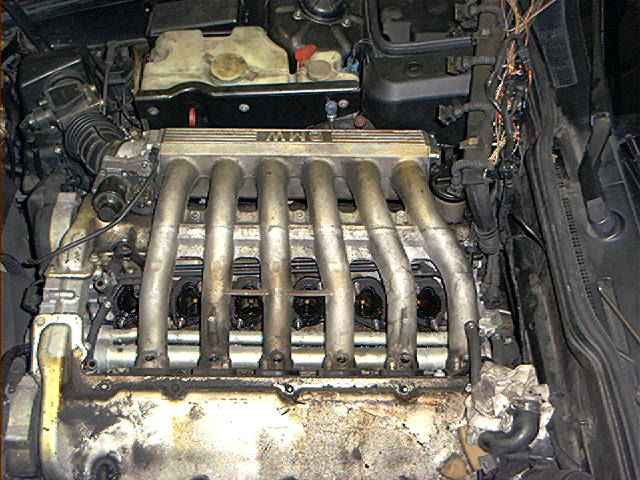
Here you see the bottom of the
intake manifold. Notice the attached DK motor. The black trim is
the noise suppressor. The arrow is showing the connection hose of
the fuel evaporative vent system. The hose is going from the
intake manifold to the evaporative purge valve. This hose can't
be disconnected with the manifold installed (unless you are
detaching the DK motor), so may be its a good time to replace it
now while your at it. In my case the hose was hardened, cracked
and brittle. You can use any ordinary 8mm fuel hose for this:
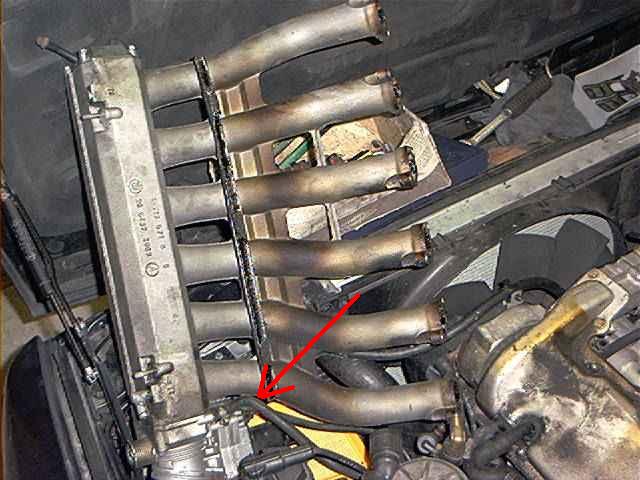
After cleaning things up and
degreasing the connecting surfaces (the gaskets and the intake
manifold) I put some sealant on the surfaces. Don't overdo this.
It looks like a heavy coat of sealant, but it isn't. Just a thin
layer. My workbench is a bit messy here but it was getting late
and I was in a real hurry...:
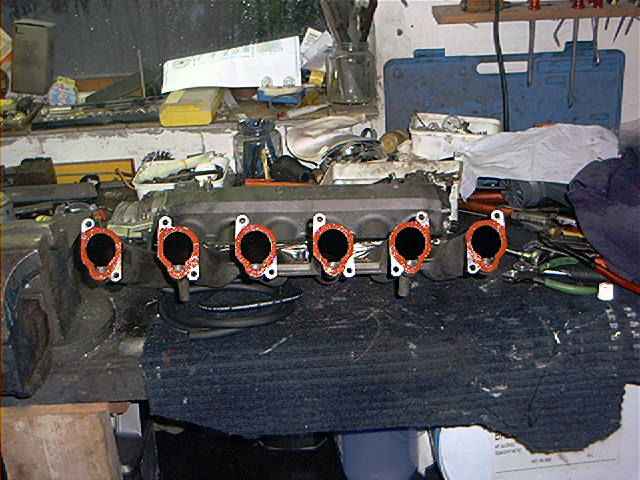
This part was added later, at February 2005: later on, I developed again false air problems. When replacing my valve stem seals, I decided to remove every intake gasket (because both manifolds are removed anyway) to reseal them with sealant. I took some pictures while doing that.
Both intakes removed:
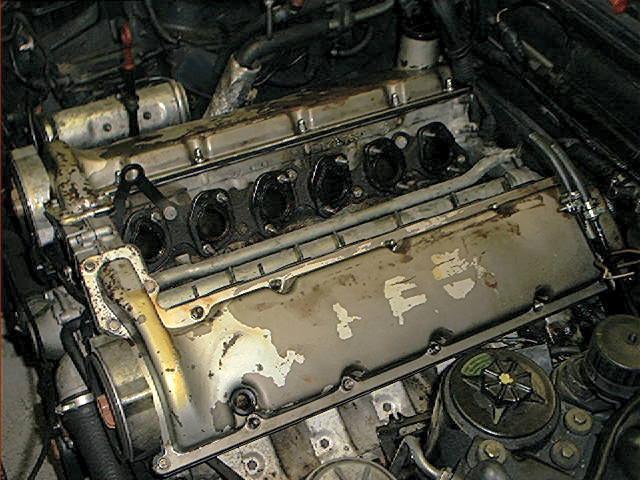
Removing the intake gaskets,
just a couple of 13mm nuts:
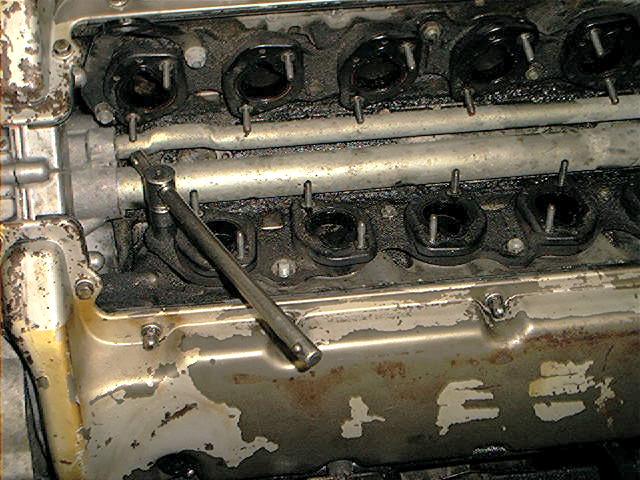
Removed intake gaskets from one
bank:
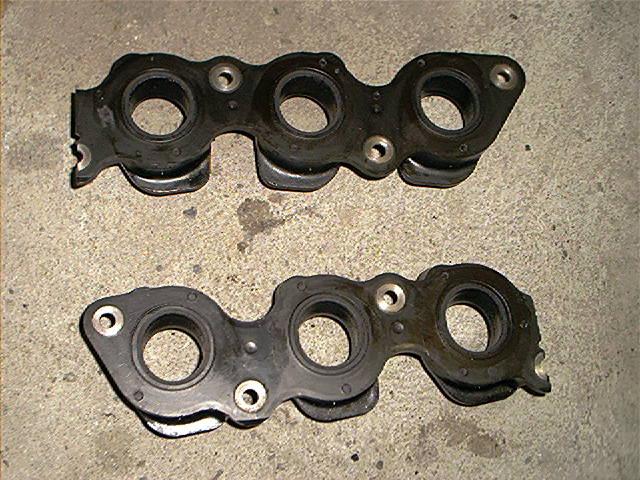
Notice how thick they are:

Cleaning the gaskets. These are
still the original ones from '87 (build date Nov 1987 model year
1988):

Notice the cracks. Normally this
is a good reason to replace them, but I assumed the sealant will
do its job properly:

Cleaning and degreasing the
surfaces of the intake ports, gaskets laying on top of the valve
cover:

Applying sealant, one intake
gasket already installed:

And installing the manifold. I
used a little to much sealant..hmm...:
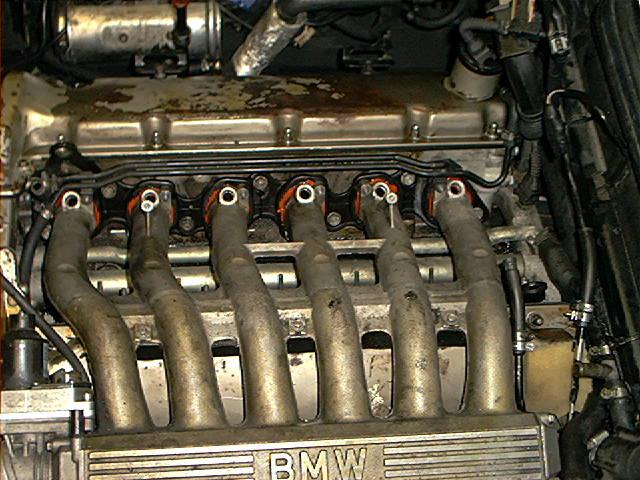
That was about it. After this I reinstalled the manifolds. Don't overtighten those manifold bolts, it isn't necessary. Just 10 NM (7 ft-lb) will do. Start in the middle and work your way round. Use grease again for the socket, to prevent those bolts falling out when installing. Furthermore, the reinstallation is pretty much the reversal of removal.
There has to be a reason why
even new intake gaskets seem to fail again over a certain period
of time. I think it has something to do with the manifold support
brackets mounted onto the valve cover, as shown here:

Just make sure the brackets are in place, the rubber mount is still in one piece and that the manifold is bolted tight to the brackets. A lot of people seem to remove the plastic ignition wire guides but if you don't reinstall the small nuts of the guides, the manifold isn't bolted to the brackets anymore...this put to much stress to the intake gaskets. Make sure both brackets are securely mounted to the manifold.
The next picture shows the
manifold tightened to a support bracket, without the ignition
wire guides. I used a thick washer between the bracket and the
nut (remark: I got this washer from a set of discarded wire
guides..they are simply to remove from the guides):
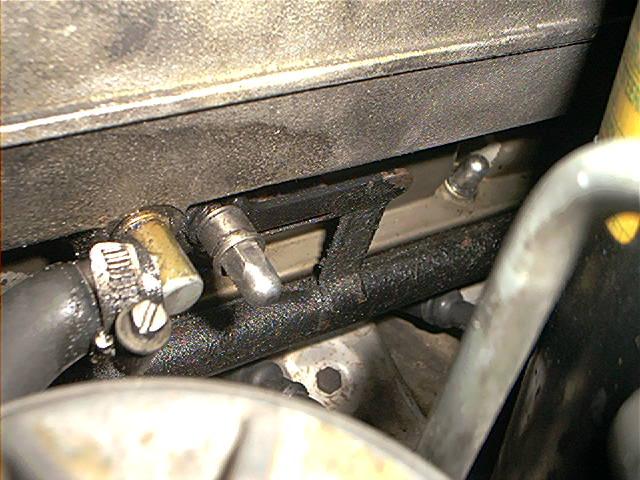
Total
amount of parts and cost:
None. Just some
sealant and a new purge valve hose.
Total
amount of time:
At least a full
day.
Skills
needed/difficulty level:
Definitely good
technical skills. Don't drop the nuts into the valley.
Satisfactory
level after the job done:
Smooth idle now.
Don't do just one manifold like I did the first time, but do them
both and also seal the gaskets between the gasket and the
cylinder head.
Story by Sean750.
If you would like to add any comments, remarks and/or corrections to this procedure, feel free to email Mike Oswald and we'll put it on our site. Share your experiences with us so others may benefit from it.